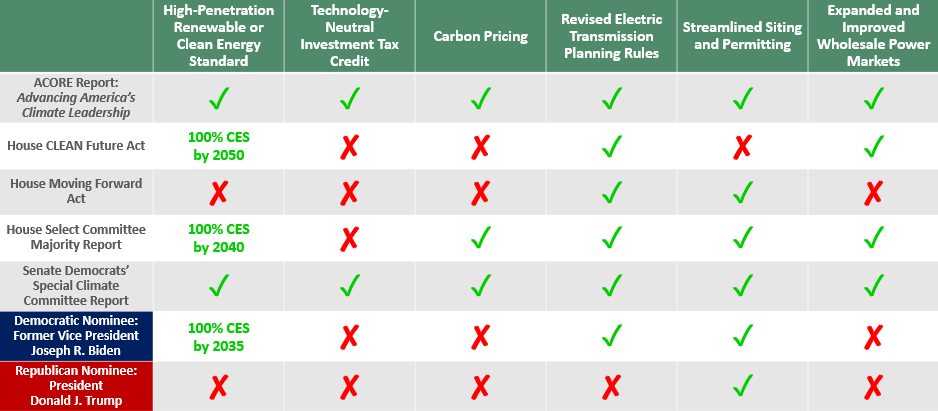- Project Finance
- Siting & Permitting Reform
- Tax Incentives & Appropriations
- Transmission & Power Markets
- Blog
Connecting the Dots: Smart Climate Policy Coalescing Around Key Priorities
By: Tyler Stoff
October 27, 2020
In January 2020, ACORE released Advancing America’s Climate Leadership: Policy Options That Most Effectively Put Renewable Energy to Work, a report that examined notable climate policy approaches for their impact on renewable energy growth and investment, including a federal high-penetration renewable or clean energy standard, a technology-neutral tax credit, carbon pricing regimes, and complementary measures to ready the electric grid for the higher levels of renewable energy penetration necessary to achieve ambitious greenhouse gas emission reductions.
Since release, ACORE’s core report recommendations have been found across a broad array of new policymaker proposals, including those from multiple congressional committees and both major party presidential nominees. The below chart highlights how ACORE’s suite of policy recommendations faired across these plans, including the House Energy & Commerce Committee’s CLEAN Future Act, the House Transportation & Infrastructure Committee’s Moving Forward Act, the House Select Committee on the Climate Crisis’s Majority Staff Report, the Senate Democrats’ Special Committee on the Climate Crisis Case for Climate Action Report, Democratic presidential nominee Joe Biden’s clean energy plan and Republican presidential nominee and incumbent President Donald Trump’s agenda.

Connecting the dots of the policymaking record, certain trends are immediately apparent. With the exception of President Trump’s agenda, high-penetration renewable or clean energy standards have taken center stage among premier climate plans, likely because such a policy represents a direct and reliable way to ensure scientifically driven emissions reductions in the electricity sector. At the same time, attention has to some degree shifted away from economy-wide carbon pricing, which fails to find a home among either presidential nominees’ plans. However, carbon pricing at some level is important to address the roughly two thirds of greenhouse gas emissions outside the power sector and the carbon “leakage” that could otherwise occur under a power sector-only approach. Newer policy options, like a technology-neutral tax credit for zero- or low-carbon electricity generation, have started to find their footing among the House and Senate committees that spent the most time diving into comprehensive climate solutions, boding well for this tool, which would simplify the tax code and incentivize the market to produce cost-effective climate outcomes.
Policymakers increasingly see the value of modernizing our antiquated electrical grid to better accommodate the growth of clean energy spurred by these other climate policy options. Revised electric transmission planning rules enable the creation of a Macro Grid. A fully planned and integrated Macro Grid can connect centers of high renewable resources with centers of high electric demand. With the exception of President Trump’s agenda, enhanced transmission planning garners widespread support. Streamlined project siting and permitting is a bipartisan priority, though parties tend to pursue this objective in differing ways. One approach is to weaken existing regulations, while another is to establish new agencies to help streamline permitting. We believe it is possible to streamline and accelerate permitting without weakening environmental safeguards.
Expanded and improved wholesale power markets enable greater deployment of renewable energy by better balancing supply and demand, creating new opportunities for renewable growth while increasing the economic efficiency of the bulk power system. This is a complicated issue, and former Vice President Biden’s campaign hasn’t actively previewed power market reform. At the same time, President Trump’s administration has moved in the opposite direction, erecting new barriers to renewable integration in the nation’s wholesale power markets.
Accelerating the transition to a renewable energy economy requires a combination of policy approaches. Beyond climate, renewable energy is an increasingly critical component of the nation’s power mix, outcompeting fossil sources of electricity, delivering tangible economic benefits and getting Americans back to work. With more than $57 billion in U.S. private sector investment last year, renewable energy is one of the nation’s most important economic drivers and a critical source of jobs and economic growth. ACORE has worked hard to grow a clean energy policy consensus over the past year, but there is still important work ahead.
Join leaders from across the renewable energy sector.

What will our next 20 years look like? Here’s the truth: they’ll be better with ACORE at the forefront of energy policy.
Shannon Kellogg
Amazon Web Services (AWS)
